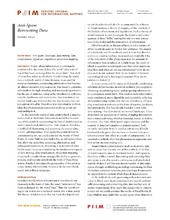Anti-Spam: Reinventing Data
Peer reviewed, Journal article
Published version
Permanent lenke
https://hdl.handle.net/1956/8954Utgivelsesdato
2012Metadata
Vis full innførselSamlinger
Sammendrag
Today, where information is continually transferred in the form of data, the word “information” has all but been exchanged for the word “data.” This shift of terms has aided in effectively transforming the world into a network-world of data. In many areas, and for many professionals, condensing information has become an almost exclusive preoccupation. This need to condense information through selecting and summarizing events—via the use of statistics, infography, visualization software, reports, databases, and animations—has dominated our mental landscape; it dominates the way we structure our perception of reality. Therefore, it is important to rethink what this phenomenon represents and how artists are responding to it. In this network-world of data spam (which is unsolicited e-mail or electronic data sent en mass) has become one of the symbols representing the flux of disinformation, and/or unsolicited, information. Anti-spam is, therefore, a method of eliminating and screening the source data, a tool I call impedance. If we apply this point of view to contemporary art, we could consider the works of Pavel Braila, R. Luke DuBois and André Sier as anti-spam filters that allow the detection, screening, elimination, and subsequent reinvention of existing or non-existent data. In this essay, I propose considering the fundamental aspects of data mining, data visualization, projection mapping. From such considerations emerges the ability to generate, process, and recreate data from the work of these three artists. Finally, I introduce the perspective of the artist as a data miner, this reinvents its source in the new visual, social and political datascape.
